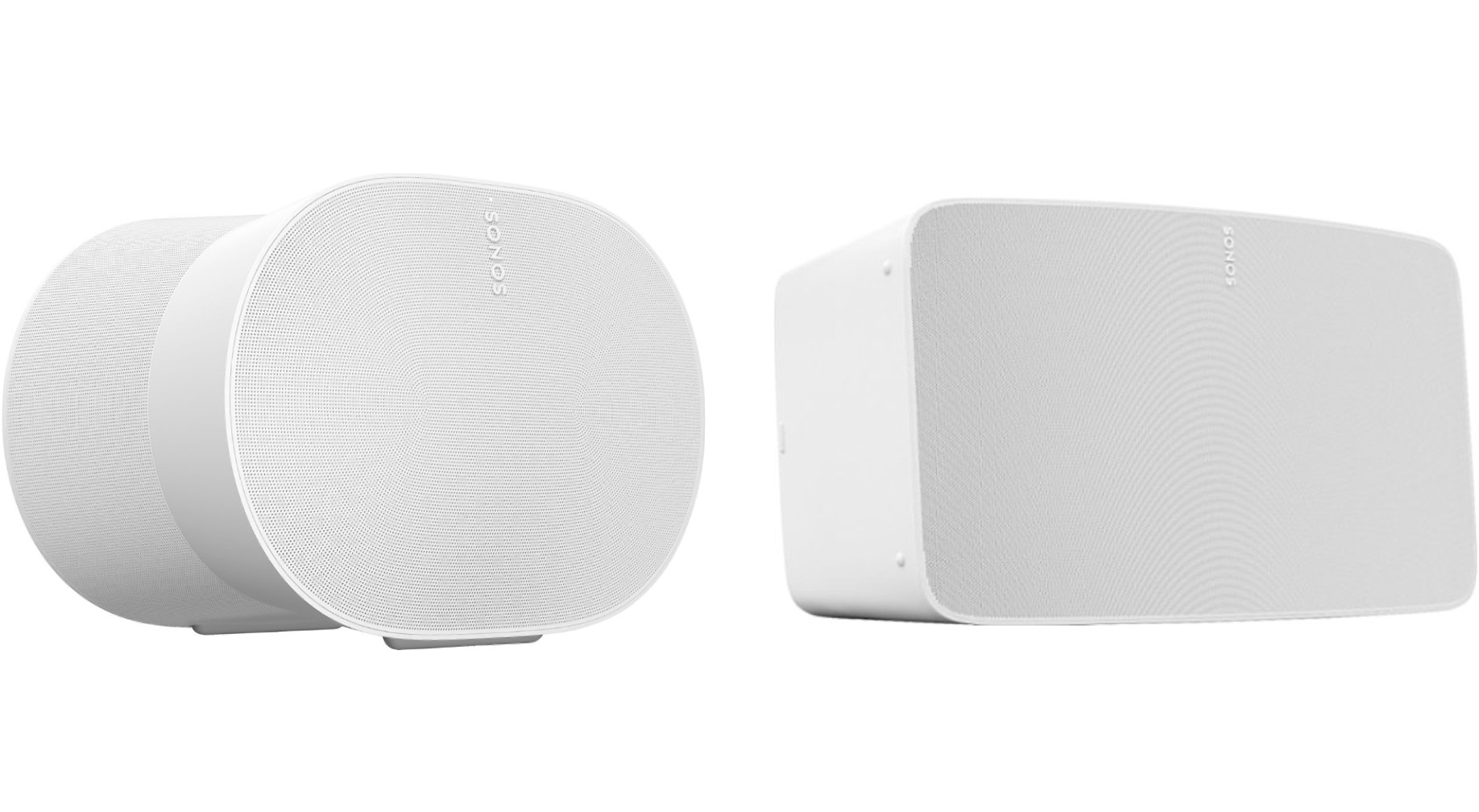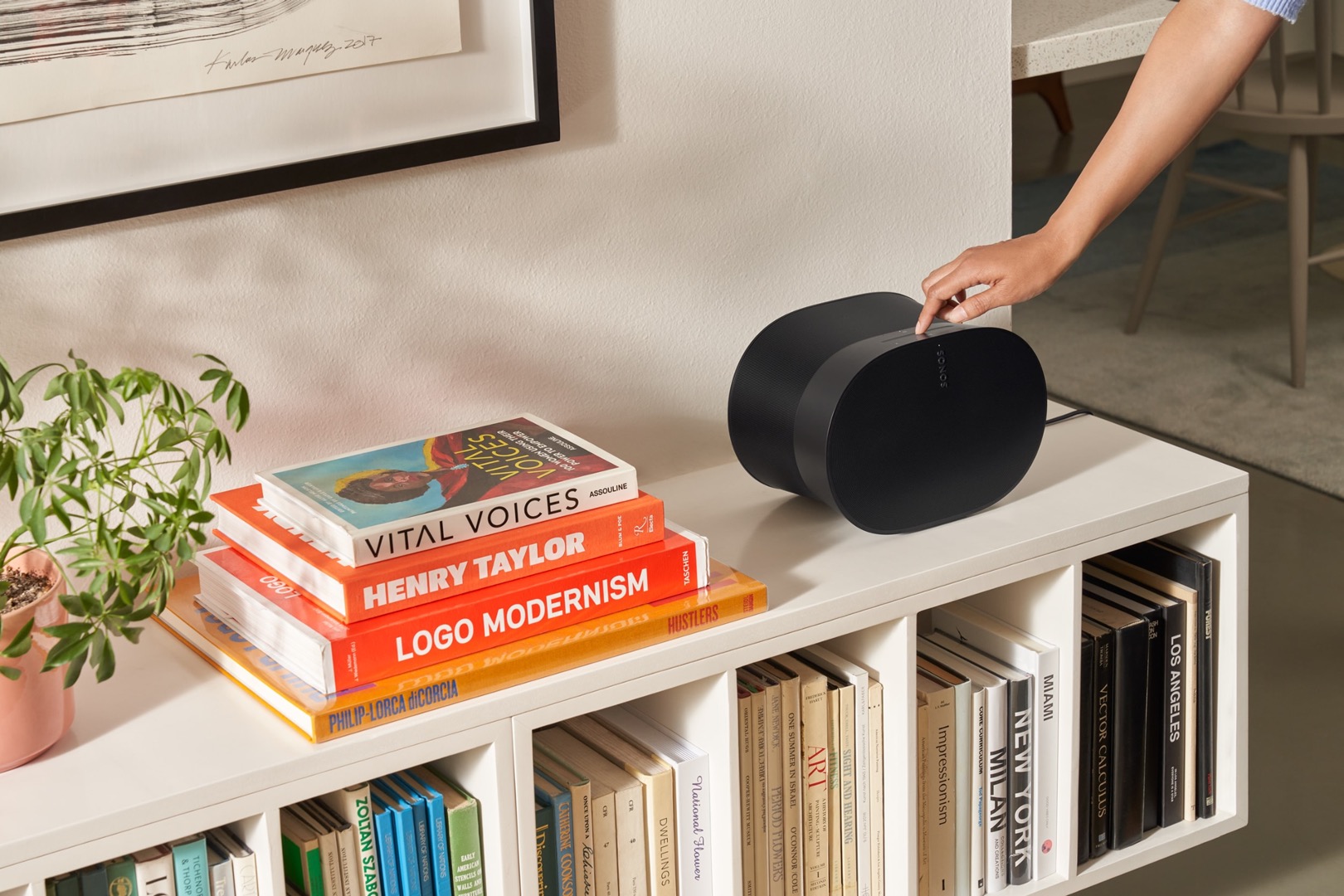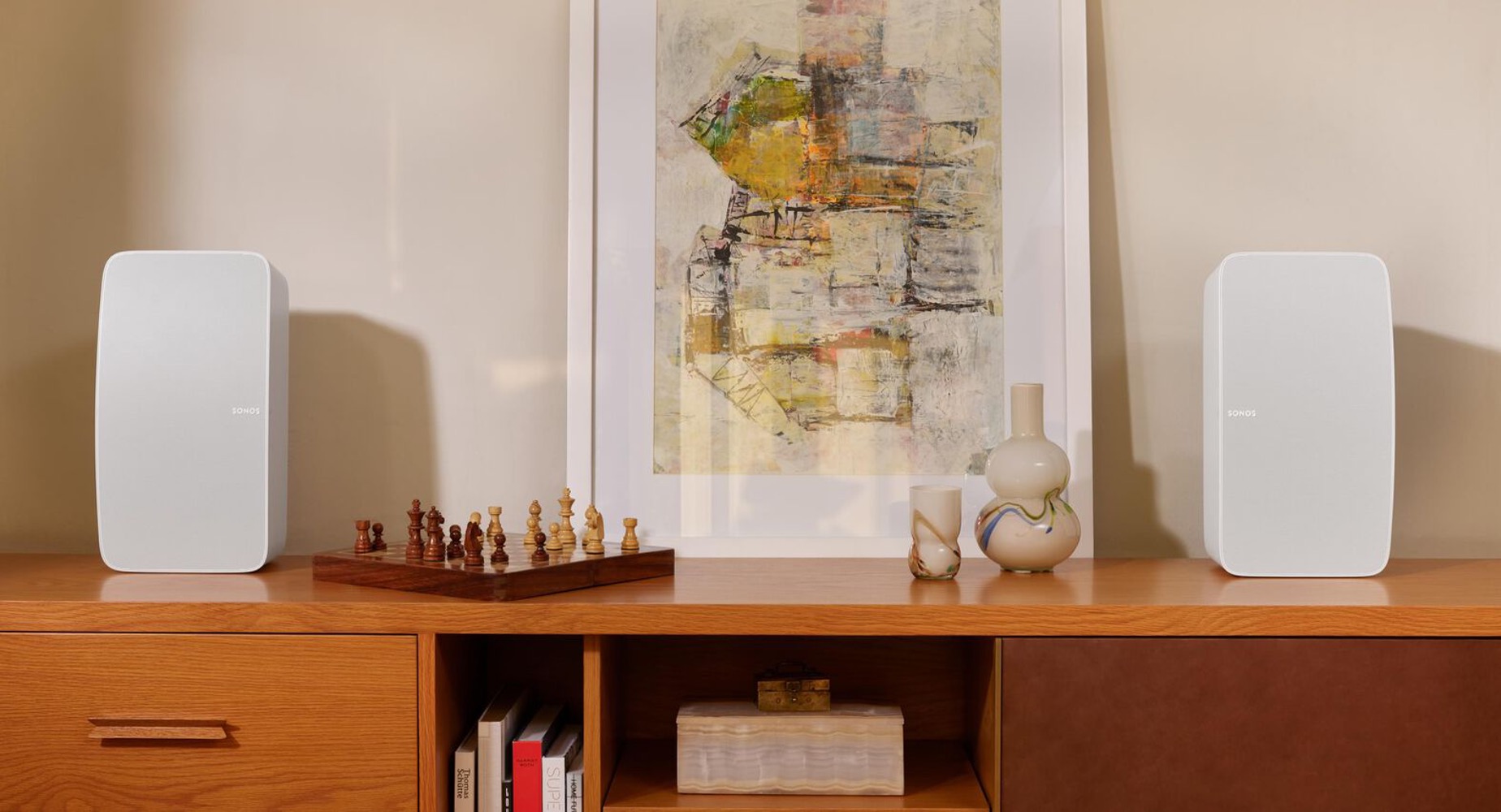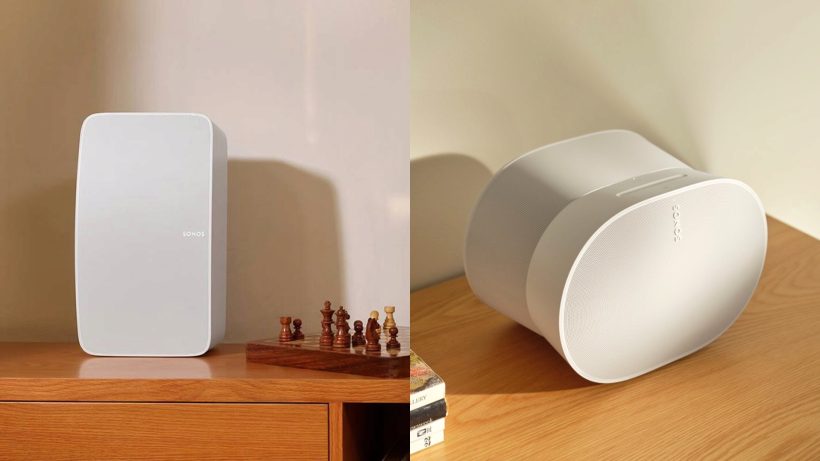The Sonos Era 300 and Sonos Five are some of the most advanced speakers from Sonos that are designed to deliver superb sound quality, but there are a few differences between both speakers.
The Sonos Era 300 is actually designed for spatial audio and works extremely well within a Sonos home theater setup (together with the Sonos Arc and Sonos Sub). This speaker delivers a room-filling audio experience with its six drivers, including two sideways firing woofers, two sideways firing tweeters, one up firing tweeter, and one front facing tweeter, all powered by six Class-D amplifiers. It supports Bluetooth 5.0, Wi-Fi 6, AirPlay 2, and has a USB-C port for connectivity. One of the key differences is that this speaker is voice-enabled and supports spatial audio, making it ideal for immersive listening and home theater.
In contrast, the Sonos Five has a more traditional design and focuses on pure Hi-Fi audio quality and stereo sound formats. It consists of six drivers: three mid/bass units, two angled tweeters facing outwards, and a front facing tweeter. It lacks Bluetooth connectivity but includes Ethernet, Wi-Fi, AirPlay 2, and a 3.5mm line-in. The Five is not voice-enabled and does not support spatial audio, so it’s a speaker that you would get for traditional stereo listening.
In terms of placement and size, the Era 300 requires open space around it for optimal performance due to its multi-directional sound, while the Sonos Five can be placed in more confined spaces like a bookshelf without impacting its performance (the Sonos Five works nicely as bookshelf speakers). Both speakers are available in black or white, but the Era 300 features a more modern design with enhanced usability features.
After hours of testing both speakers, we can comfortably say that the Sonos Era 300 is more suited for home theater listening (together with the Sonos Arc and Sonos Sub) and they work extremely well as Dolby Atmos speaker with 3D spatial imaging. The Sonos Five on the other hand delivers a more traditional stereo sound performance (they deliver great soundstage and separation) and is designed for casual listening.
Read also: Our full in-depth review of the Sonos Era 300 Dolby Atmos speakers

Comparing the Specs
| Feature | Sonos Era 300 | Sonos Five |
|---|---|---|
| Audio | Six class-D amplifiers, four tweeters, two woofers | Six Class-D amplifiers, three tweeters, three midwoofers |
| Spatial Audio Support | Dolby Atmos | No |
| Microphones | Advanced beamforming, multichannel echo cancellation | No |
| Adjustable EQ | Via Sonos app | Via Sonos app |
| Trueplay | Compatible with iOS and Android devices | Requires supported iOS device |
| Dimensions (HxWxD) | 6.3 in x 10.24 in x 7.28 in | 7.99 in x 14.33 in x 6.06 in |
| Weight | 9.85 lbs (4.47 kg) | 13.89 lbs (6.3 kg) |
| Colors | Black, White | Black, White |
| Finish | Matte | Matte |
| Controls | Capacitive touch controls | Capacitive touch controls |
| Connectivity | WiFi, Bluetooth, USB-C, Apple AirPlay 2 | WiFi, Apple AirPlay 2, 3.5 mm line in, Ethernet |
| Voice Control | Compatible with Sonos Voice Control and Amazon Alexa | No |
| Power Supply | Internal, 100-240V 50/60Hz | Internal, 100-240V 50/60Hz |
| CPU and Memory | Quad Core, 4xA55 1.9GHz, 2GB DDR4, 8GB eMMC | Quad Core, 1.3 GHz, 512 MB SDRAM, 512 MB NAND Flash |
From the above table, the key difference between both speakers is that the Sonos Era 300 delivers support for Dolby Atmos and comes equipped with an advanced microphone array for voice control and Bluetooth connectivity. It also offers a more versatile set of connections including WiFi, Bluetooth, USB-C, and Apple AirPlay 2.
In contrast, the Sonos Five being an older model lacks Bluetooth connectivity and voice control features but excels in delivering high-fidelity sound with a focus on deep bass and stereo separation. It offers a simple set of connections: WiFi, Apple AirPlay 2, a 3.5mm line-in and an Ethernet port.
Both speakers are designed with touch controls and adjustable EQ via the Sonos app. They also share features like humidity resistance and a matte finish available in black and white colors. The Sonos Five is slightly larger and heavier than the Era 300.

Sound Performance Comparison
The Sonos Era 300 is designed to deliver a room-filling and immersive audio experience and is equipped with six drivers and Class-D amplifiers. This speaker excels in delivering spatial audio and Dolby Atmos sound, making it ideal for watching movies and listening to 3D sound effects. The Era 300 is also the first non-Apple device to support Apple’s Spatial Audio technology.
We really liked the sound quality of the Sonos Era 300 speaker. This speaker delivers superb 3D sound performance when paired inside a home theater setup together with the Sonos Arc. The speaker is capable of delivering superb highs and detailed midranges with really nice highs (vocals sound exceptionally clear). It has the ability to reproduce 3D separation and has really nice soundstage; you can listen to these speakers and pick out where each sound is coming from (even sounds that are coming from overhead).
On the other hand, the Sonos Five is tailored for stereo listening and is designed to provide a balanced sound signature with really good soundstage and separation. The speaker is equipped with six drivers, including mid/bass units and angled tweeters. While the Sonos Five does not support spatial audio, it excels in delivering high-fidelity audio quality. We played a couple of live jazz performances and the Sonos Five speaker had better sonic presence than the Sonos Era 300 – music performances by Dusty Springfield sounded extremely realistic with exceptional clarity and timbre, and her vocals sounded warmth and refined.
Playing the same soundtrack on the Sonos Era 300, we felt that they have less sonic presence and soundstage; the sound felt rather “artificial” as compared to the level of realism that you get with the Sonos Five speaker (the Sonos Fives also sounded much louder overall). That being said, the Sonos Era 300 performed better while watching movies due to the 3D spatial imaging and movie effects that you can hear reverb all around the room.
The bottom line is if you listen to a lot of movies and music with Dolby Atmos support, the Sonos Era 300 will definitely perform better because of its spatial sound performance. If you don’t really use Dolby Atmos and just want a proper speaker to listen to high-fidelity sound, the Sonos Fives are a better choice.
Both the Sonos Era 300 and the Sonos Five speakers have decent bass but not the kind of low-end bass that you would expect to get with a dedicated subwoofer. We highly recommend pairing both speakers with the Sonos Sub (Gen 3) to get deeper bass performance for home theater.

Design
The Sonos Era 300 speakers has a unique hour-glass shape and comes with modern features like an enhanced volume slider and a modified power cable. It is designed to deliver multi-directional sound and requires a more open space for optimal performance particularly for overhead sound effects to really shine.
The Sonos Five by contrast is similar to the original Sonos Play:5 from 2009. The speaker is more suited for placement in tighter spaces like a bookshelf without compromising performance. Both models are available in black or white, with the Era 300 featuring a more contemporary style that can be placed on bookshelves, while the Five offers a classic aesthetic that looks great in any modern living space.
The Verdict?
We would personally go for the Sonos Era 300 speakers compared with the Sonos Five. While the Sonos Five does deliver better sound performance as a “standalone” speaker, we like the versatility that the Sonos Era 300 provides especially if you want to upgrade to a home theater setting in the future by adding the Sonos Arc and Sonos Sub (which pairs seamlessly with the Sonos Era 300 over Wi-Fi).
The Sonos Five also has more limited connectivity options and does not support smart voice assistants, making it more like a traditional stereo sound system. We did enjoy the level of soundstage and detail that the Sonos Five has to offer though, and music performances did have more sonic “presence” as compared to the Sonos Era 300. That being said, with Dolby Atmos sound becoming more common (especially if you watch a lot of Dolby Atmos movies), the Sonos Era 300 is a good choice and can be easily integrated into any Sonos home theater setup in the future, which is a nice added advantage.

